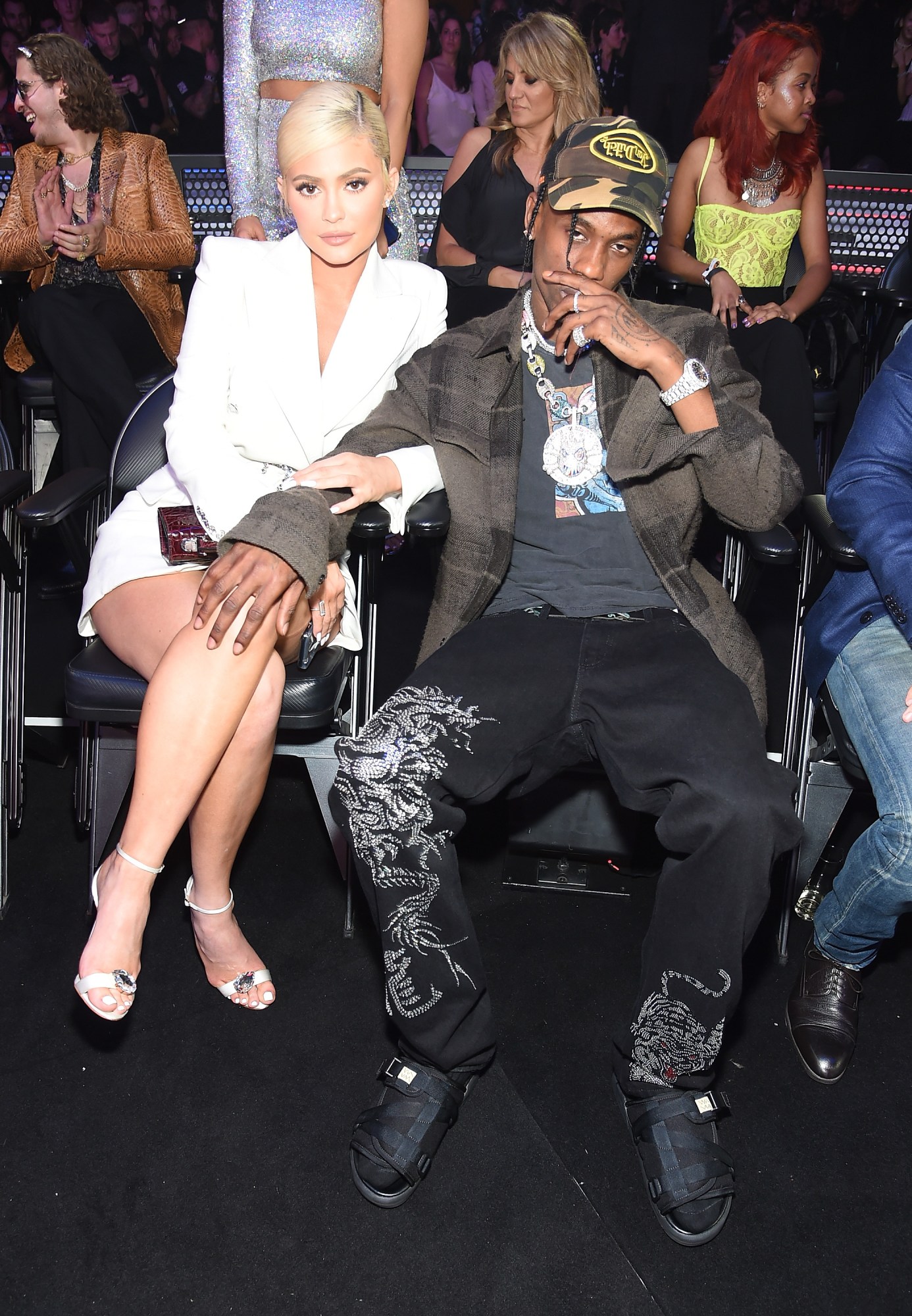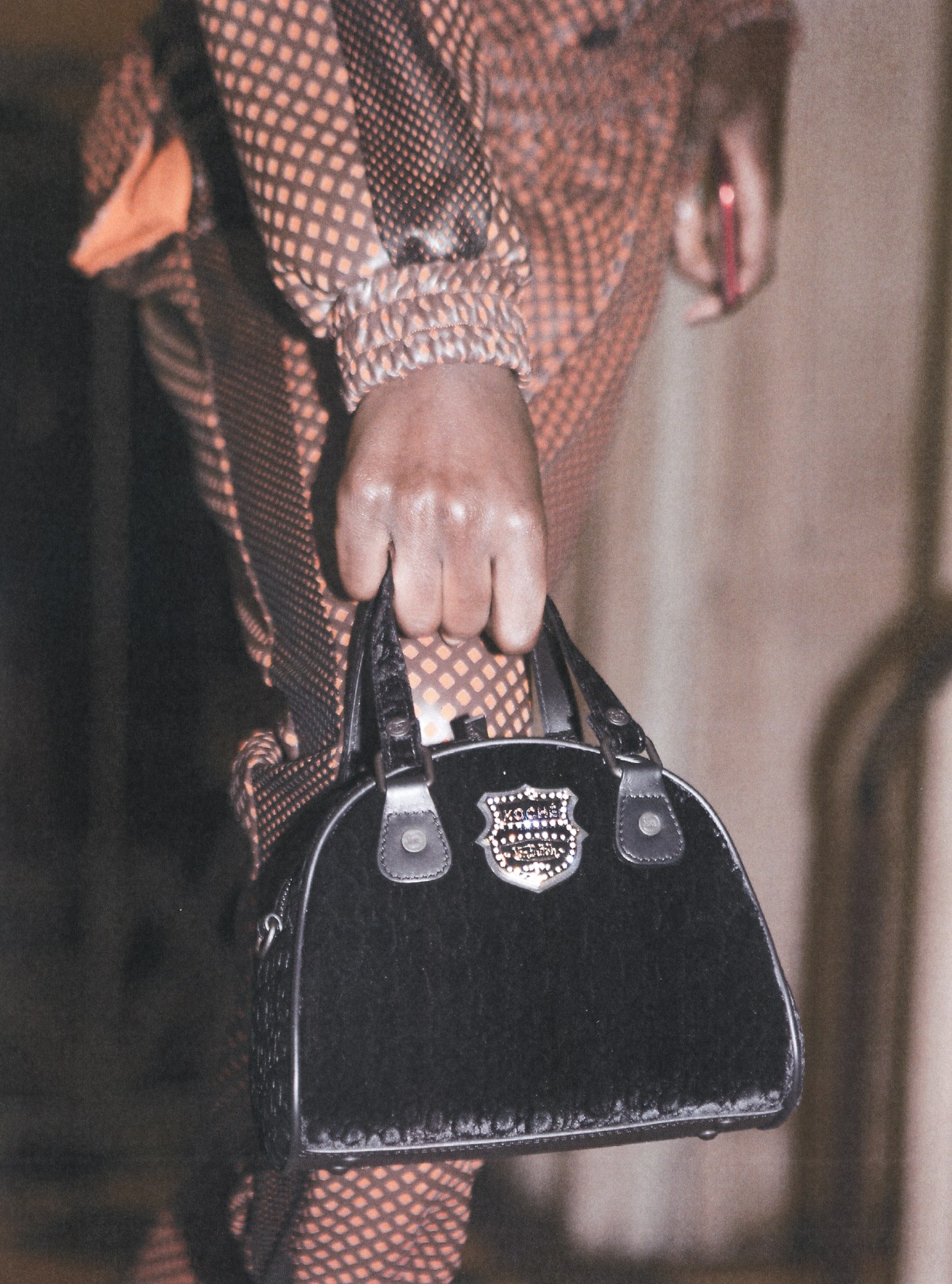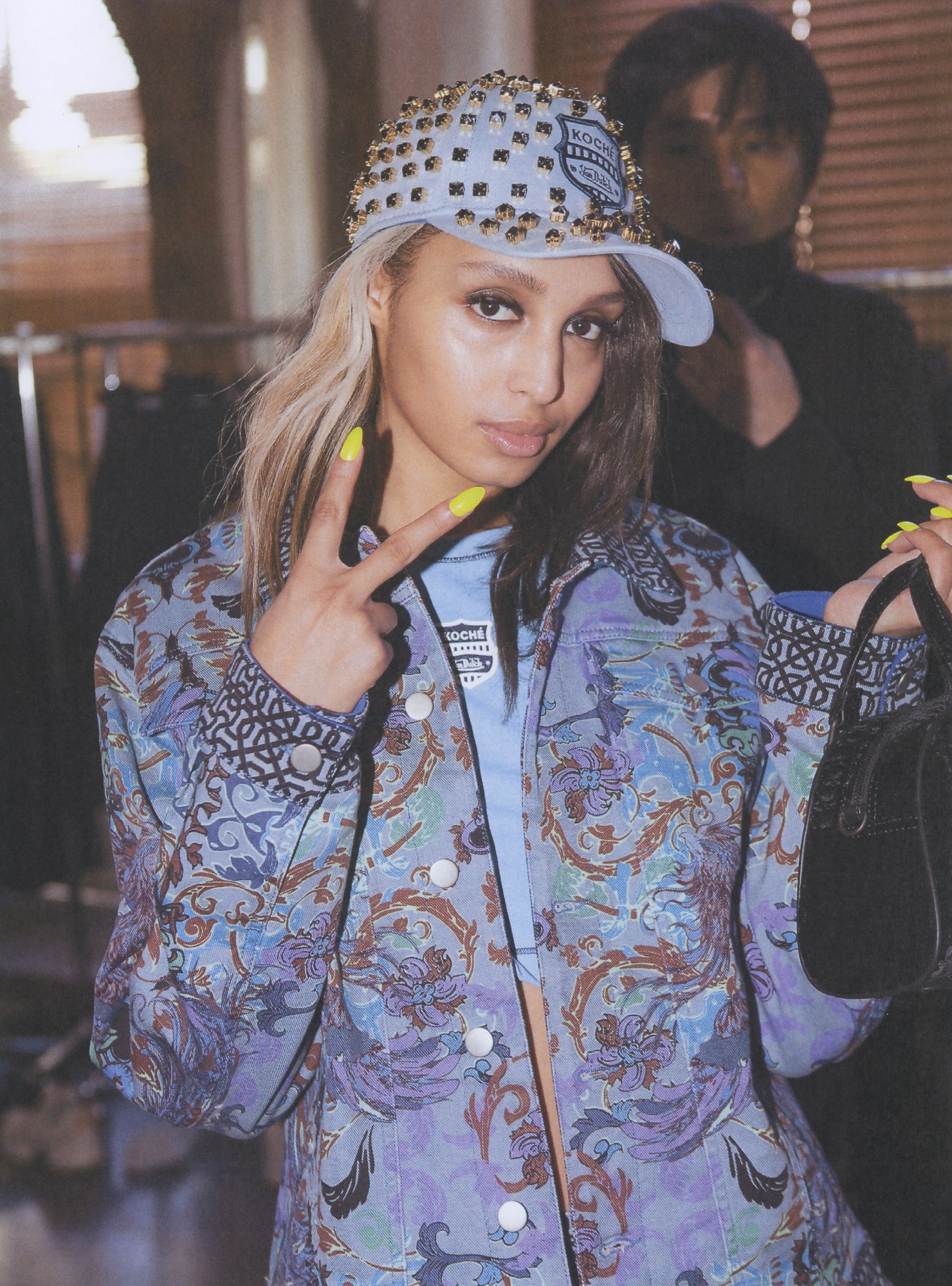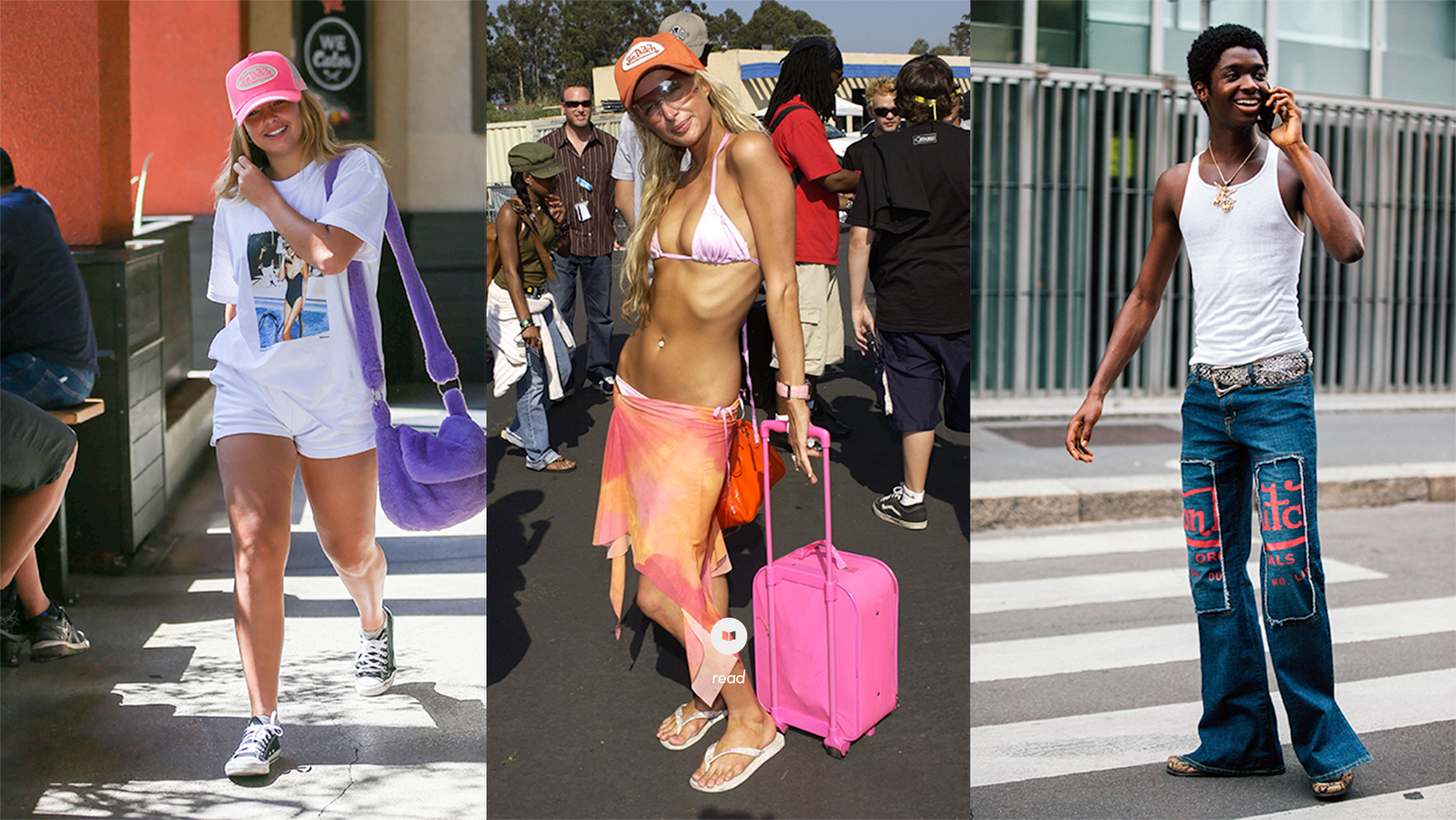There are few things as integral to the rhinestone-spangled early-2000s than trash fashion. It was a time where even Topshop was seen in the pages of Vogue, and midriffs were exposed with gusto. Would the world have even continued turning without the Hilton sisters’ slinky ‘got blow?’ slogan tank tops, those seedy “Miss June” Playboy necklaces, or, first and foremost, the iconic Von Dutch trucker hat? We think not!
After a couple of years lurking in the shadows, Von Dutch has joined the likes of Juicy Couture, Miss Sixty and even Groovy Chick on the list of labels to have been resurrected by fashion’s frenzied obsession with its chintziest era. But how exactly did a brand that borrows its name from a bigoted American pinstriper become Kylie Jenner’s go-to on a bad hair day?
It all started in 1999, when entrepreneurs Michael Cassel and Robert Vaughn acquired the rights to the original Von Dutch name from the family of Kenny Howard, who had died seven years prior. An instrumental figure in the Southern Californian Kustom Kulture movement of the 1950s, wherein racers and artists alike would link up to admire the latest and greatest in custom vehicles. Kenny was renowned for his signature fuel tanks bearing elegant freehand pinstripes, monstrous flying eyeballs and flame-kissed tribal patterns. Later in later life, though, his racist and anti-semitic statements would come to overshadow his work.
When Vaughn and Cassel acquired the tarnished name, they decided to bring in French stylist and denim connoisseur Christian Audigier as its Creative Director, tasking him with turning these bold graphics into big bucks for the brand. Originally from Avignon, the largest town in France’s denim heartland (the fabric’s name actually derives from ‘de Nîmes’, a nearby town), he’d long been obsessed with American culture. He dropped out of school early, following the death of his father, and landed a sales assistant job that sparked the obsession with American vintage that eventually led him to launch his own denim brand, Top Sider.
After a trip to Bali resulted in his imprisonment, Christian decided to start over in LA, fuelled by fantasies of biker gangs and Route 66. “He wasn’t making a lot of money at that time, but he had big dreams,” says Fabrice Sopoglian, the creative mind behind 2018 documentary Christian Audigier The VIF. He initially met his subject at a bar in the late 90s, back when the designer was running with Hollywood film stars Jean-Claude Van Damme and Mickey Rourke. He had always dreamt of becoming a rockstar, “but unfortunately he did not have a good singing voice,” the producer jokes. So he did the next best thing, and dressed them instead.
What made him successful at that, though, was that Christian was one of the first marketers to truly understand the value of getting famous faces to wear your brand, and all at a time when the nation’s eyes couldn’t have been more focused on the A-List. A key moment for Von Dutch came about when an “I’m A Slave 4 U ”-era Britney Spears chanced upon the brand’s Melrose Avenue flagship one sunny morning in 2002. Legend has it that Christian flagged down the pop sensation and managed to graft her into accepting one of the brand’s signature caps as a gift. The following week, she and Justin Timberlake called it quits, and the Von Dutch logo-emblazoned fallout set the tabloids ablaze

From then on, everyone from Cheryl Cole to Missy Elliott, Jordan to — most notable of all — Paris Hilton wanted a piece of the trucking pie. Like the furry UGG boot, or Juicy Couture’s terrycloth tracksuit, the brand became a go-to for celeb off-licence runs and gruesome walks of shame, all captured by salivating paparazzi. Anna Nicole Smith would even don her own custom Cowboy trucker on Jimmy Fallon, complete with a matching baby pink bowling bag, a true vision of Mc-Bling style.
At the height of Von Dutch’s success in 2004, however, Christian Audigier left his booming empire following an argument with investor Tony Sorensen over his desire for a bigger role in the company. He retaliated by setting up an equally garish rival brand, Ed Hardy. As the 2010s approached, and the sexy simplicity of labels like American Apparel came into vogue, life kicked dirt in the Von Dutch’s eyes with a pair of Toms plimsolls, relegating its colourful trucker hats from a bona fide A-list fave to the realm of corny Halloween costumes and eBay bargain-buys.
Now back in the business of serving LA’s entertainment elite, the brand has since cleared all their licenses and kissed goodbye to the mass-marketing strategies that led to the brand’s dilution. Instead, it’s adopted a limited drop system based on feeling, not season. “We didn’t really put too much thinking behind what it would become,” says Ed Goldman, Von Dutch’s General Director, “it was just like, ‘What do we actually like?’”
Having spotted the Y2K revival from a mile off, he joined the team back in 2019, tasked with masterminding exactly how Von Dutch would return to the top of the hat-making hierarchy. He carved out a strategic path, with stops along the way including: making over its admittedly “dumpy” Melrose Avenue flagship; turning its signature trucker caps into hot-ticket items at $89; creating strong links with LA’s hip-hop community – amassing approval from Travis Scott and Megan Thee Stallion among others; and collaborating with a host of rising social media stars, from Emma Chamberlain to Lil Huddy.

“Around March 2020, there was a ton of social media interaction with some top-tier celebrities and rappers, and that’s what got it going. It literally went from one to 100 overnight,” says Goldman. “There wasn’t a big marketing effort on our part to try and revive Von Dutch. We just talked to a lot of people on the street and really tried to connect with what matters in American culture today.”
Steeped in nostalgia as the brand’s reboot is, Goldman believes that pivoting to a streetwear model — following in the footsteps of Palace and Supreme with limited drops and collaborations — is the key to keeping things as fresh as possible for the brand’s future. Among those recently brought on board is Christelle Kocher, the founder of Parisian label Koché. They’ve joined forces on a brand new capsule, with her trajectory within the industry a perfect reflection of all that Von Dutch hope to achieve with their comeback: embracing couture-level craft techniques while also responding to fashion as it lives and breathes on the streets.
“It’s as if the Trucker girl became a woman and went to Paris,’ says Earl Pickens, the brand’s Executive Director of Design, of the collaboration. Tasked with shaping the brand’s new vision for an entire generation that had never worn the logo, for him, the endeavour is all about elevating Von Dutch’s core principles, blending the world of the rough and rugged biker and the contemporary hip-hop scene. “There was also a feminine touch that I was looking for, and Christelle brought just that,” Earl continues, “she’s taken our pinstriping and brought it to a new generation, glammed up in a velvet bowling bag.”

To Christelle, the opportunity was a dream come true. “It’s been great to reinterpret such an iconic part of my life growing up,” the designer says, proudly admitting to stealing her older brother’s Von Dutch trucker cap on the regular. A self-professed pop-culture obsessive, she’s remained committed to keeping the spirit of Von Dutch intact, all while taking it to new heights with fine embellishments and hand embroideries.
“The early 00s was a period of time where people had fun. It was playful and, in a way, it was also a naïve time,” says Kocher. “I feel we all need more naïve and spontaneous moments. Everything can feel quite heavy these days and I believe that fashion has a role to play in making the world a bit more fun and open. Y2K style reminds people of this period, and it makes them smile.”
Of course, there’s good cause for excitement for Von Dutch’s viral comeback. But, popular as they were in their heyday, “they weren’t the most innovative designs,” says Bridget Gushue, the eagle-eyed aughts-obsessed Instagrammer behind @literaltrash2004. “It’s a patch that says “Von Dutch” on a trucker hat, but when Paris and Britney wore it, the world needed it.” Though the excessive branding might not be to her liking, she concedes that they’re a faithful testament to the era, describing their return as the result of “a perfect storm” fuelled by millennials who never really left the decade behind. “It also feels like the younger generation saw how colourful, vibrant, irreverent and fun the fashion was of that era and wanted to bring that energy into the present,” Bridget adds.
Well, they succeeded. From polka-dotted sliders and pastel pink graffiti tracksuits to a brand new Pride cap and an upcoming Hulu series detailing the label’s mighty rise and fall, it’s safe to say the brand is re-cementing its status in popular culture for a new generation. Love it or hate it, Von Dutch will always be an obsession that some deem worthy of tapping into.




